Physical Address
304 North Cardinal St.
Dorchester Center, MA 02124
The spectrum of uterine lesions of mesenchymal and mixed mesenchymal-epithelial type has expanded in recent years, largely due to the cumulative experience reported in larger case series, as well as the identification of recurrent gene fusions and other molecular alterations. In routine practice, the approach to most mesenchymal neoplasms encountered in the uterus starts with a judicious morphologic approach, which in many cases suffices for the diagnosis. Smooth muscle tumors predominate, most of them being benign. The distinction of conventional and variant leiomyoma types from leiomyosarcoma is important but on occasion challenging, and some lesions remain in the category of unknown malignant potential. Endometrial stromal neoplasms follow in frequency; their distinction from other mesenchymal lesions may be difficult, and molecular testing is gaining momentum as a key ancillary tool in their diagnosis. These two major categories are covered in depth here, along with other mesenchymal lesions with significant occurrence in the uterus. An emphasis is given on the differential diagnosis of each entity. This chapter also covers neoplasms with mixed mesenchymal and epithelial components (except endometrial polyp, which is presented in Chapter 9 ); of these, the most important clinically is adenosarcoma. The chapter concludes with miscellaneous lesions of histopathologic diagnostic importance.
Smooth Muscle Neoplasms
Leiomyoma is the most common neoplasm in women; approximately 70%–75% of resected uteri for benign conditions harbor this tumor type. The frequency slowly increases with age: ∼20%–30% of women under 30 years have leiomyomas, compared to 40%–50% of women 40 years or older. Black women are more likely to be affected in whom they tend to be larger and more numerous. In spite of their high frequency, only a subset (∼25%) are symptomatic; large and submucosal lesions are more likely to produce symptoms. They are a common source of menorrhagia, dysmenorrhea, and infertility in reproductive-age women and postmenopausal bleeding, urinary incontinence, and prolapse in postmenopausal women. Large intramural and subserosal leiomyomas may present with pelvic pressure or bloating. Much less frequent clinical findings include secondary erythrocytosis, uterine rupture, uterine infection, and ascites (pseudo-Meigs syndrome).
Clinically, large and bulky leiomyomas can be palpated on clinical pelvic and abdominal examination. On imaging, they are well-demarcated solid nodules. Although the primary imaging modality is transvaginal ultrasound, magnetic resonance imaging (MRI) offers higher specificity as it can better identify degenerative changes (hemorrhage, pseudocystic degeneration, ischemic-type change) and features concerning for malignancy (signal heterogeneity, tumor cell necrosis, irregular borders).
Leiomyomas range in size from <1 cm to >25 cm. When multiple, they are randomly distributed throughout the uterus. The conventional macroscopic appearance is of a well-demarcated, nonencapsulated spherical or ovoid mass situated in the uterine wall. Depending on its location, the lesion can bulge into the endometrium and be accompanied by mucosal ulceration and hemorrhage or toward the peritoneal cavity, where they may be pedunculated and attached to the wall by a thin stalk. In the latter scenario, the leiomyoma sometimes detaches, leaving it free within the peritoneal cavity; subsequent adhesion to bowel or other abdominal or pelvic structures leads to the phenomenon of “parasitic leiomyoma.” Leiomyomas grow under the tension exerted by the uterine wall; so, upon sectioning, such tension is released and the cut surface of the tumor protrudes from the wall and the tumor shells out quite easily from the surrounding myometrium. The cut surface is usually rubbery, with a firmer consistency compared to the normal myometrium. It has a white-to-grey color and a vaguely trabeculated or whorled visual aspect ( Fig. 11.1 ).

A spectrum of degenerative changes can be seen in uterine leiomyomata. Ischemic infarction with superimposed hemorrhage has been associated with pregnancy and hormonal treatment; it is seen macroscopically as diffuse red soft tissue (carneous, “beefy” degeneration) ( Fig. 11.2 ). Localized ischemic change and hemorrhage can also lead to pseudocystic degeneration and calcifications. Focal infarction can be soft yellow or densely firm (scar tissue), depending on the evolution of the necrotic area over time ( Fig. 11.3 ). In the context of previous arterial embolization, these focal ischemic changes can be seen in association with visible foreign material within uterine and parametrial vascular spaces.
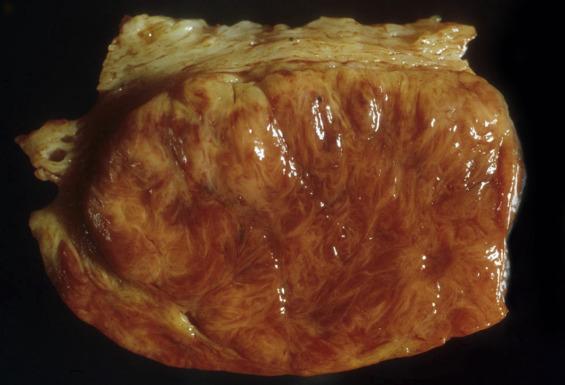
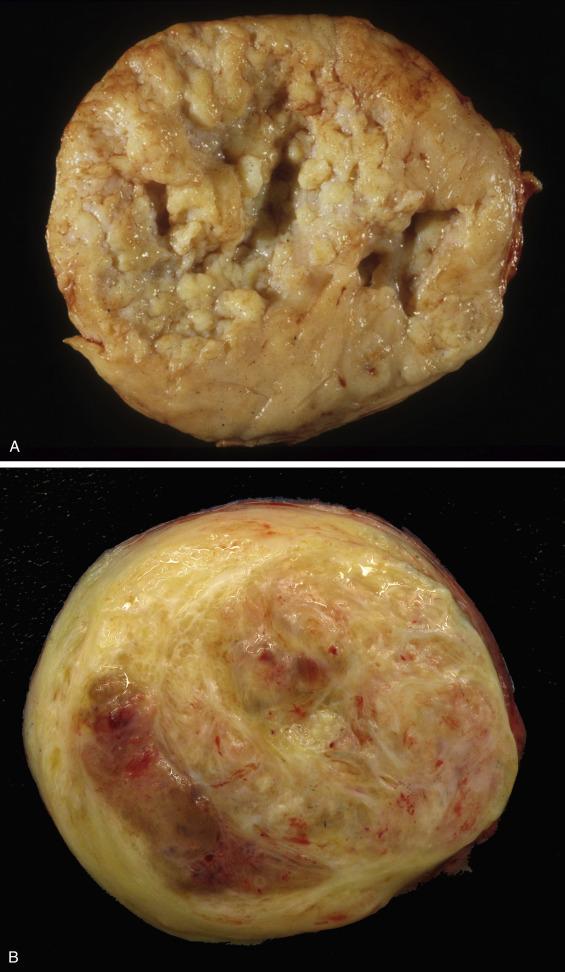
Leiomyoma variants have certain peculiar macroscopic characteristics. Highly cellular leiomyoma and epithelioid leiomyoma are soft rather than firm or rubbery (given their hypercellularity and lesser amount of extracellular matrix) ( Fig. 11.4 ). Myxoid leiomyoma is also soft and often gelatinous (due to the abundance of myxoid stroma). Lipoleiomyoma has a heterogeneous cut surface with soft yellow areas (adipose tissue) admixed with firm rubbery areas (smooth muscle tissue) ( Fig. 11.5 ). Dissecting leiomyoma has focal worm-like protrusions into the surrounding wall, sometimes into vascular spaces (namely, leiomyoma with intravascular intrusion). The term cotyledonoid leiomyoma applies when most of the tumor outline displays a worm-like or bulbous appearance resembling the cotyledons on the maternal surface of the placenta ( Fig. 11.6 ). Diffuse leiomyomatosis is characterized by diffuse thickening of the myometrium by innumerable small (<1 cm) tumorlets.
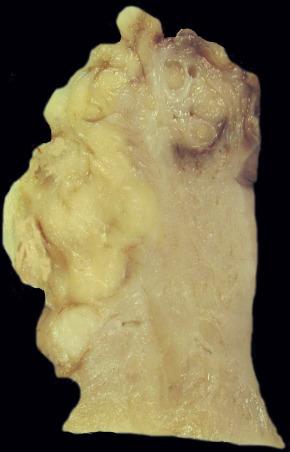
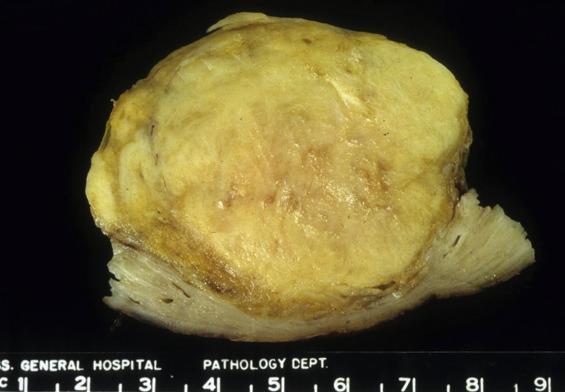
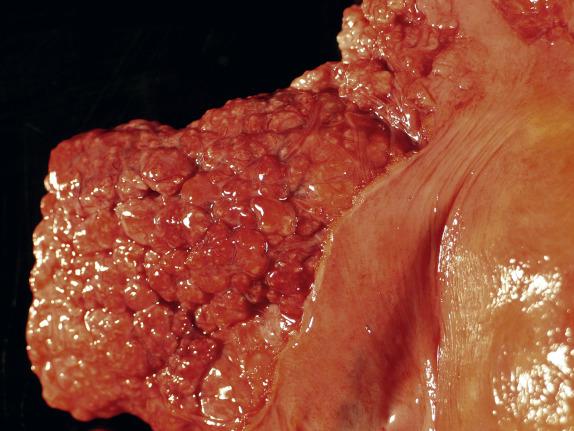
Upon careful macroscopic examination, if all lesions show features of conventional leiomyoma as described earlier, partial representative sampling is sufficient. Popular grossing references recommend up to three representative sections. In my practice, we submit up to one-to-three sections if the largest leiomyoma is 5 cm or less in diameter and two sections per each 5 cm of the diameter of the largest leiomyoma if more than 5 cm. Any lesion with unusual findings, including degenerative-type change, soft consistency, hemorrhage, and necrosis, requires more extensive sampling (one section per centimeter of the tumor diameter is suggested) which should also include the border with the myometrium.
Conventional leiomyomas appear as well-circumscribed lesions with cellularity closely approaching that of normal myometrium (normocellular). They are typically well demarcated from the surrounding myometrium but sometimes can have irregular interdigitation. Submucosal leiomyomas may show surface endometrial ulceration or, more commonly, thinning of the endometrial lining with paucity or absence of glands. In curettage specimens, this is seen as fragments of endometrium devoid of glands and composed only of normal stroma and surface epithelium (“aglandular functionalis”). Leiomyomata are characteristically composed of fascicles of smooth muscle that intersect each other at different angles and are closely apposed and form whorls, which is distinct from the orderly and more evenly spaced fascicle distribution of the myometrium ( Fig. 11.7A ). Each fascicle represents a bundle of fusiform cells with abundant eosinophilic cytoplasm and elongated “cigar-shaped” nuclei (based on the round, tapered ends on each side), which are classic morphologic features of smooth muscle differentiation. The spindle shape of the cells and their nuclei can be appreciated if the fascicle is cut longitudinally; fascicles sampled transversally in the histologic section contain nuclei with a round to ovoid shape (corresponding to their short axis), often with a paranuclear vacuole. Nuclei are monotonous and do not vary significantly in size or shape and the chromatin pattern is uniform, ranging from pale to hyperchromatic ( Fig. 11.7A , inset). Nuclear palisading is not uncommonly encountered, sometimes to such a degree that the tumor may resemble a Schwannoma. The blood vessels present within leiomyoma are variably sized; the presence of large and thick-walled vessels dispersed throughout is characteristic ( Fig. 11.7B ). The extracellular matrix is collagenous and usually indistinct but can be more prominent in between fascicles. Dense collagen deposition is seen in areas of resolving ischemia as eosinophilic, “hyalinized” bands or patches ( Fig. 11.7C ). Sometimes, collagen is more nodular and aggregated around vessels.
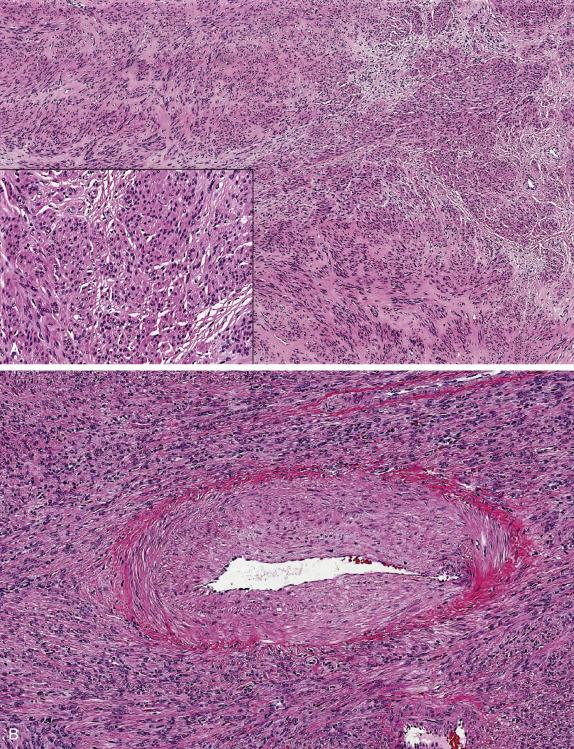
Ischemic-type necrosis, degenerative in nature, has a distinct microscopic appearance. If recent, the devitalized areas are eosinophilic but retain the outlines of the tumor nuclei as well as the vascular network. In the ischemic area, the transition occurs over a broad zone featuring a gradient progression of viable to nonviable cells, with the tumor cells increasingly separated by collagen, hemorrhage, and granulation tissue toward the infarcted zone ( Fig. 11.8A ). In old, healed infarcts, the devitalized area is largely replaced by dense collagen, and the gradient zone is more attenuated. Sprinkled histocytes with golden to yellow cytoplasmic granules are sometimes seen; the granules represent cysteine crystals and result from degradation of the infarcted tissue. Another type of degenerative change is the so-called hydropic degeneration, in which significant edema separates the muscle bundles and causes pseudocyst formation. The hydropic areas are hypocellular and often contain fibroblasts and inflammatory cells ( Fig. 11.9 ).
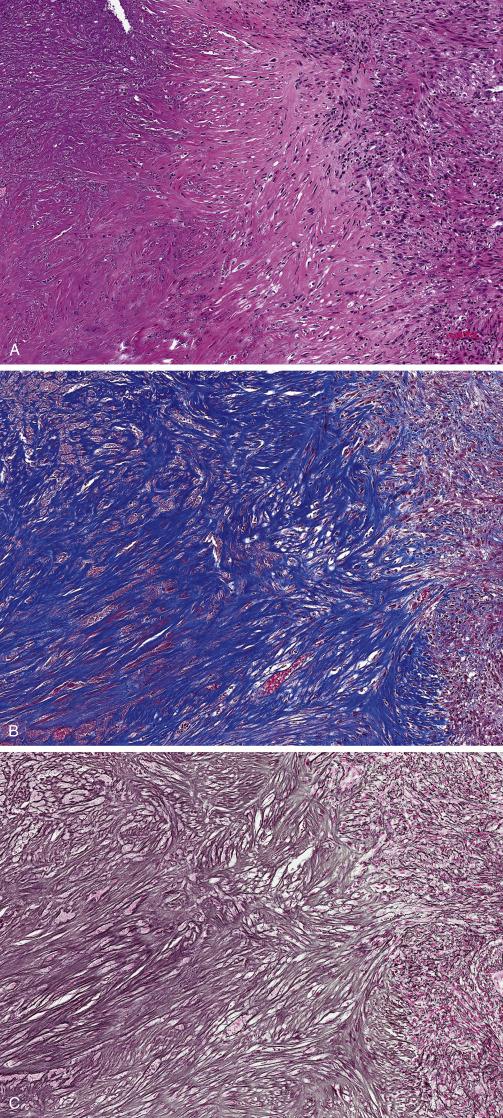
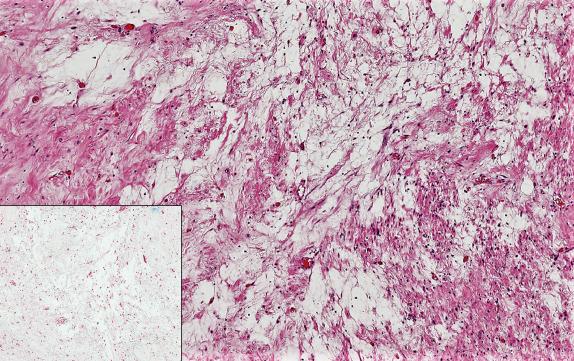
Changes induced by pregnancy and medical treatment: In the setting of pregnancy or high-dose exogenous progestin treatment, leiomyomas undergo hyalinization, myxoid change, and hemorrhage ( Fig. 11.10 ). The tumor cell population appears plumper due to increased amounts of cytoplasm. Hypercellularity, nuclear pleomorphism, and mitotic activity (up to 9 mitoses/10 high-power fields [HPFs]) can be seen focally, around zones of hemorrhage and/or myxoid change. Importantly, the proliferation should be restricted to the periphery of degenerated areas. The walls of large muscular vessels also undergo fibrosis and myxoid change. Hemorrhage can be quite extensive, corresponding to the so-called “carneous degeneration” seen macroscopically.
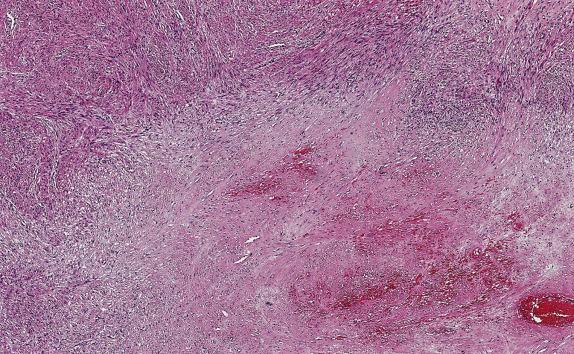
Medical treatment with gonadotropin releasing hormone agonists (GnRHa) has been associated with ischemic-type necrosis, hyalinization, inflammation, and apoptosis; increased mitotic activity has also been reported shortly after discontinuation of this treatment. Ulipristal acetate is a selective progesterone receptor (PR) modulator increasingly used in the management of symptomatic leiomyomas; however, the morphologic changes induced by this family of agents have not been extensively studied. Like GnRHa, ulipristal treatment leads to shrinkage of the tumor; it has been shown that this occurs due to induction of cell apoptosis and remodeling of the extracellular matrix. Changes observed include sclerosis, hyalinization, vascular necrosis, apoptotic bodies, and low Ki67 index.
Leiomyomas resected after previous uterine arterial embolization with polyvinyl alcohol or trisacryl gelatine microspheres display ischemic-type necrosis of varying amounts and evolution. The embolic material is often found in venous vascular spaces in the uterus, parametria, and adnexal soft tissue, associated with foreign body–type giant cell reaction ( Fig. 11.11 ). Another therapeutic technique is MRI-guided thermal ablation using ultrasound waves that induce necrosis and subsequent tumor shrinkage. This type of ablation can cause necrosis of the geographic coagulative type, which, outside of this clinical context, would be a worrisome finding. Thus, it is important to correlate this finding with the clinical history and to exclude the presence of atypia and mitoses.
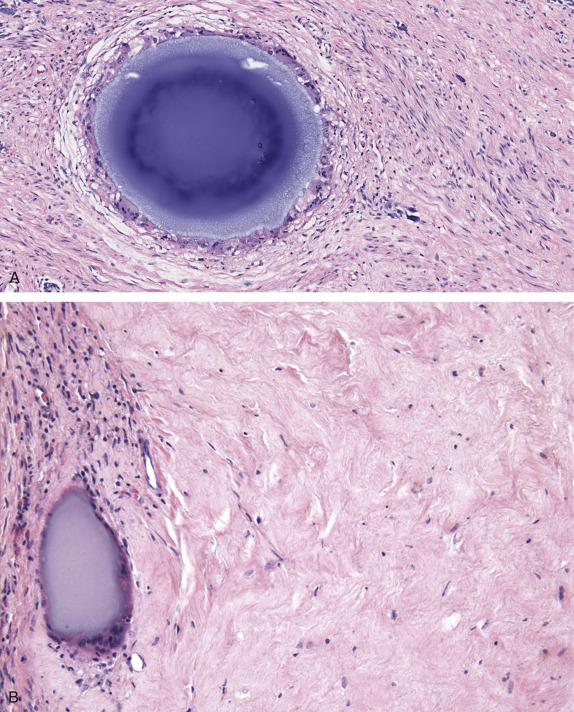
Leiomyoma variants: Morphologic variants of uterine leiomyoma are defined by the presence of one unusual histologic feature. Their recognition is important, as some of these features are used in the diagnosis of leiomyosarcoma. However, in isolation, they do not portend a malignant diagnosis. These include:
Leiomyoma with bizarre nuclei (LMBN) (discussed in the next section).
Mitotically active leiomyoma : Tumors with mitotic counts of 5 to 15 mitoses/10 HPFs are classified as “mitotically active”. In the absence of significant nuclear atypia and tumor cell necrosis, these tumors behave indolently. The increased proliferation may be related to ischemia or progesterone effect (either endogenous or exogenous), supported by the fact that this leiomyoma variant is almost exclusively seen in reproductive-age women.
Cellular and highly cellular leiomyoma : These tumors are defined as showing cellularity that is higher than normal myometrium (cellular) or which is reminiscent of the cellularity of a low-grade endometrial stromal neoplasm (highly cellular) ( Fig. 11.12 ). They otherwise show conventional features including fascicular growth, low to absent mitoses, no atypia (e.g. nuclear enlargement, hyperchromasia, irregular nuclear contour), and no tumor cell necrosis. Characteristic features of the highly cellular variant include large thick-walled vessels and cleft-like spaces.
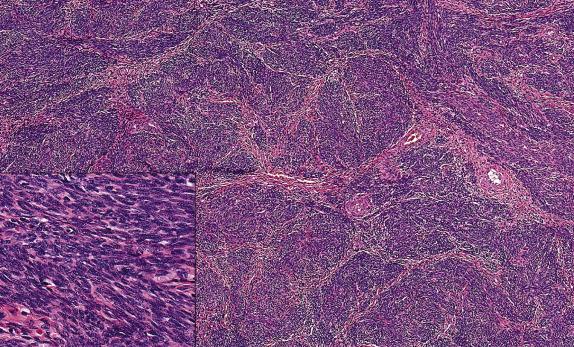
Dissecting leiomyoma : This variant has a focal or more extensive irregular interface with the surrounding myometrium characterized by worm-like or nodular bulbous protrusions ( Fig. 11.13A ). This permeative growth can, on occasion, extend into the parametrial soft tissue and broad ligament. When striking, the term “cotyledonoid leiomyoma” has been employed. The nodules are composed of disorganized bundles of smooth muscle which typically have a “swirled” rather than fascicular configuration as well as a prominent vascular component, which is accentuated at the periphery of the nodules due to the commonly associated hydropic change ( Fig. 11.13B ). A related phenomenon is leiomyoma with intravascular intrusion , in which an otherwise conventional leiomyoma permeates into the lumen of an adjacent vessel. In all these scenarios, the tumor has bland cytomorphology few mitoses, and lacks coagulative necrosis and infiltrative (destructive) invasion.
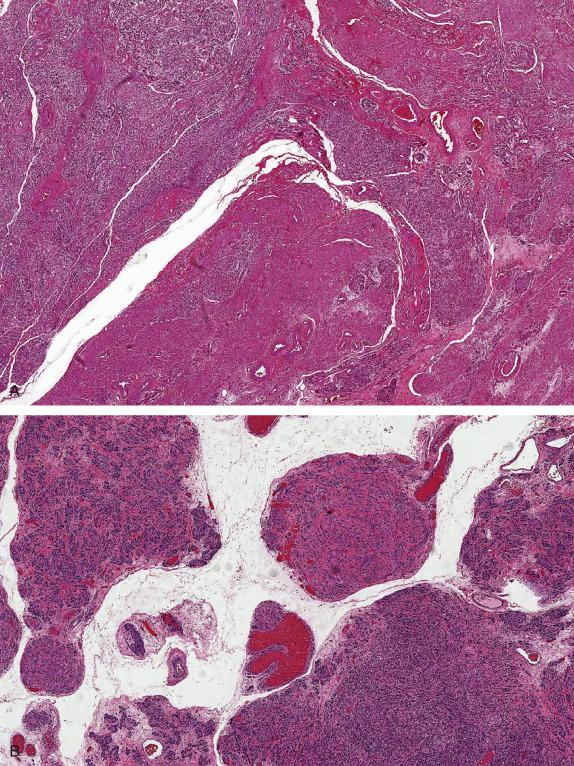
Epithelioid leiomyoma : Epithelioid morphology (resembling an epithelial tumor) is not an infrequent finding in otherwise conventional (spindle cell) leiomyomas. Sometimes, leiomyomas have focal areas in which there are anastomosing cords of cells containing scant clear cytoplasm set within a collagenous matrix; in this scenario, the epithelioid appearance is imparted by the abundant matrix and does not represent “true” epithelioid change. Leiomyomas with this appearance have been termed “plexiform leiomyomas,” and when small, “plexiform tumorlets”; in the latter, the nodules are ≤1 cm. The term epithelioid leiomyoma should be applied if epithelioid morphology, in the form of solid aggregates, cords, and trabeculae of cells with round to ovoid shape with moderate to abundant eosinophilic cytoplasm and a central round nucleus, is present in ≥50% of tumor cells ( Fig. 11.14 ). This morphology extends beyond that expected for cells that appear rounded due to excess collagenous matrix or a cross-sectioned smooth muscle fascicle. By definition, epithelioid leiomyoma should have smooth, noninfiltrative borders and a mitotic count of less than 5 mitoses/10 HPFs. It should also lack significant nuclear atypia and geographic tumor cell necrosis.
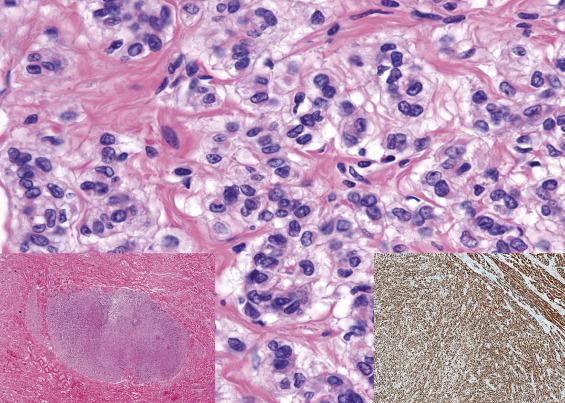
Myxoid leiomyoma : Myxoid change is defined as accumulation of an extracellular matrix rich in glycosaminoglycans (particularly hyaluronic acid), which imparts a soft gelatinous microscopic appearance and a pale blue-violet tinctorial quality in routine histologic preparations. Myxoid change often occurs in leiomyomas focally, commonly associated with ischemia and hemorrhage, and therefore believed to represent a degenerative change. The term myxoid leiomyoma should be reserved for lesions with myxoid stroma involving most of the tumor volume (an arbitrary designation of ≥50% has been proposed). This tumor category is exceedingly rare and believed to have a different histogenesis, although not much is known about it. This variant requires strict criteria for its diagnosis, which includes absence of tumor infiltration into the surrounding myometrium (after extensive sampling), and lack of significant atypia and tumor cell necrosis. Mitoses should be absent, or at most 1 in 10 HPFs, without atypical forms.
Leiomyoma with heterologous elements : The most common is lipoleiomyoma, in which neoplastic smooth muscle is admixed with mature adipose tissue. Other heterologous tissues encountered include skeletal muscle, cartilage, bone, and bone marrow (extramedullary hematopoiesis).
Angioleiomyoma (vascular leiomyoma): The tumor displays multiple, closely packed, often thick-walled blood vessels.
Diffuse leiomyomatosis : In this rare condition, the uterus is extensively involved by smooth muscle tumorlets, each measuring ≤1 cm and composed of bland, but often cellular, spindled smooth muscle cells that may have an ill-defined border. Perivascular aggregation can be observed.
Other very rare findings in uterine leiomyomas include collections of inflammatory cells (lymphocytes, mast cells, eosinophils, or hystiocytes) and abscess formation (usually after traumatic or spontaneous tumor rupture).
Although rarely needed in the diagnosis of leiomyoma, histochemical stains can prove useful in certain situations. Ischemic-type change is associated with replacement of the extracellular matrix with dense collagenized material; using trichrome stain, this expanded matrix will be highlighted in blue ( Fig. 11.8B ); in turn, reticulin stain will show loss of the pericellular reticulin network characteristic of viable smooth muscle ( Fig. 11.8C ). In tumors with myxoid change, Alcian blue stain at pH 2.5 will highlight the myxoid stroma (intense blue), whereas areas of edema will remain pale blue or translucent ( Fig. 11.9 , inset).
Uterine leiomyomas are positive for estrogen receptor (ER) and progesterone receptor (PR), usually in a strong and diffuse fashion. They are also positive for smooth muscle actin (SMA), desmin, smooth muscle myosin, and caldesmon, all markers of smooth muscle differentiation. Among these, SMA and desmin have high sensitivity, whereas caldesmon is the most specific. Keratin and EMA expression can be observed, mostly focal and weak, although epithelioid variants tend to have more frequent and stronger staining. CD10 is often positive and can be strong and diffuse. Ki67 proliferation index is low. There is normal expression of p53 and patchy or negative p16.
Somatic mutations in MED12 have been documented in up to 80% of conventional uterine leiomyomas. Interestingly, MED12 mutations are much less frequent in cellular leiomyoma (9%–14%). Other findings include COL4A5/6 deletions and t(12;14)(q14–15;q23–24) rearrangement (involving the HMGA2 gene and leading to HMGA2 overexpression); these changes appear to be mutually exclusive with MED12 mutations. Leiomyomas lack TP53 mutations (except those with bizarre nuclei). Karyotypic chromosomal alterations can be found in 40%–50% of leiomyomas, being the most frequent t(12;14)(q14–15;q23–24), del(7)(q22q32), 6p21 rearrangements (involving the HMGA1 gene), 10q22 rearrangements, trisomy 12, monosomy 22, 3q deletion, 7q deletion, and 1p deletion.
Diagnosis of conventional leiomyoma is straightforward. Distinction between conventional and variant forms is usually not problematic and is clinically inconsequential, as they all behave indolently. However, it is very important to become familiar with variant morphology in leiomyomas, in order not to classify them as leiomyosarcoma or other tumor types.
The most important difference between mitotically active leiomyoma and leiomyosarcoma is the absence of other worrisome features in the former (atypia, geographic necrosis). Of note, bland tumors with mitoses exceeding 15 per 10 HPFs are currently categorized as STUMP, since experience in this scenario is limited.
Highly cellular leiomyomas require distinction from an endometrial stromal nodule (ESN), which features similar degrees of cellularity. Both are well-demarcated tumors. The most helpful features in this differential are the presence of fascicular growth, thick-walled vessels throughout and strong smooth muscle marker expression in leiomyoma, and the evenly distributed, fine arteriolar vasculature and weak to absent smooth muscle marker staining of endometrial stromal neoplasms. Although CD10 is nonspecific, this marker is helpful if diffuse and strong in the absence of smooth muscle marker expression.
Given their peculiar growth, dissecting and cotyledonoid leiomyomas require distinction from endometrial stromal sarcoma . Dissecting leiomyoma may display high cellularity resembling low-grade endometrial stromal sarcoma (LG-ESS) and YWHAE-NUTM2 high-grade endometrial stromal sarcoma (HG-ESS); however, the tumor cells are fascicular and contain thick vessels. If the leiomyoma has superimposed myxoid or other degenerative change, BCOR -altered HG-ESS may be considered; however, these tumors lack prominent fascicular growth and typically have weak to absent smooth muscle marker expression. Leiomyosarcoma also deserves consideration; nonetheless, the pattern of infiltration of leiomyosarcoma is less often permeative and more frequently destructive, and overt malignant features (atypia, proliferation, necrosis) are present.
Epithelioid and myxoid leiomyoma variants require strict adherence to diagnostic criteria, particularly lack of infiltration and low to absent mitoses (less than 5 mitoses/10 HPFs for epithelioid and less than 2 mitoses/10 HPFs for myxoid). The presence of any worrisome feature should prompt consideration for epithelioid leiomyosarcoma or myxoid leiomyosarcoma , or at least STUMP (see corresponding sections). Perivascular epithelioid cell tumor (PEComa) can significantly overlap with epithelioid leiomyoma; it is typically cellular and contains epithelioid cells in tight aggregates and cords; moreover, it often expresses smooth muscle markers by immunohistochemistry. The presence of clear cytoplasm is a helpful clue for PEComa, and HMB45, Melan-A and cathepsin-K should be considered; importantly, HMB45 and cathepsin-K can be positive in leiomyomas, the latter not typically diffuse as is seen in PEComa. Other lesions with epithelioid morphology include epithelioid trophoblastic tumor and placental site trophoblastic tumor ; these proliferations have distinct cytomorphology and Ki67 proliferation index exceeding 5%–10%, which are helpful in excluding epithelioid leiomyoma (see Chapter 19 ). Inflammatory myofibroblastic tumor (IMT) enters in the differential of leiomyomas with myxoid stroma; there is significant overlap, as IMT often contains a smooth muscle-like component, and it is believed that many of these lesions are misinterpreted as leiomyoma. In myxoid areas, IMT features plump fusiform cells individually dispersed in a tissue culture-like pattern, different from the bundled arrangement of leiomyoma. Immunohistochemistry for anaplastic lymphoma kinase (ALK) and molecular testing for ALK rearrangements should be considered if a lesion has significant myxoid stroma, prominent inflammation, and/or spindle cells with wavy, pointed nuclear ends instead of the tapered end of the smooth muscle cell nucleus).
As defined earlier, leiomyoma and leiomyoma variants are benign tumors. Definitive management of uterine leiomyomata is with simple hysterectomy. More conservative approaches, however, are attempted first in most patients and often achieve optimal symptom control. Pharmacologic treatment includes progestins, oral contraceptives, aromatase inhibitors, GnRHa, and selective ER or PR modulators. Medical interventions include uterine arterial embolization, MRI-guided ultrasonic ablation, and laparoscopic or vaginal myomectomy. The latter procedure results in a tissue specimen in which a correct diagnosis of leiomyoma (conventional or variant) and the exclusion of lesions with known or unknown malignant potential, is most critical. Unfortunately, many of these myomectomy procedures morcellate the lesion(s), precluding optimal evaluation of the tumor size, tumor border, and completeness of the excision. Moreover, morcellation with powered devices has been documented to potentially result in peritoneal dissemination of the neoplasm. It has been estimated that the 5-year recurrence rate of leiomyomas after myomectomy can be as high as 60%. Other complications of myomectomy include amenorrhea, infection, sepsis and uterine rupture (sometimes months to years after, or in the setting of pregnancy).
Benign smooth muscle tumor of uterus
Most common neoplasm in women
Present in 70% of hysterectomy specimens
Estimated to occur in 40%–50% of women >40 years, 20%–30% of women <30 years
Higher incidence in black women
Symptomatic in one-third of patients
Abnormal uterine bleeding and dysmenorrhea
Abdominopelvic pain and/or pressure
Infertility, frequent spontaneous abortions, and pregnancy-related problems
Rarely erythrocytosis, infection, or ascites (pseudo-Meigs syndrome)
Benign
Hysterectomy definitive treatment
Myomectomy may be associated with tumor recurrence and peritoneal seeding (if morcellated).
Other interventions: include uterine artery embolization, ultrasonic ablation
Pharmacologic treatment includes GnRH agonists, selective PR modulators (ulipristal), and progestins.
Complications include recurrence after discontinuation of treatment, infection, and uterine rupture.
Varying size (may be >25 cm), often multiple
Location: intramural, submucosal, or subserosal
Submucosal tumors often with surface ulceration and hemorrhage
Subserosal pedunculated tumors can detach and adhere to other pelvic organs (parasitic leiomyoma)
Sharp circumscription; tumor bulges from cut surface and easily shelled out
Degenerative changes include edema, pseudocystic change, calcification, hemorrhage
Rubbery/firm, white/gray, whorled cut surface
Highly cellular leiomyoma, epithelioid leiomyoma: soft, tan to yellow
Myxoid leiomyoma: soft gelatinous
Lipoleiomyoma: heterogeneous appearance with yellow soft areas
Dissecting leiomyoma: worm-like processes into myometrium or uterine vessels (intravascular intrusion)
Cotyledonoid leiomyoma: bulging outline resembling placental surface
Diffuse leiomyomatosis: diffuse uterine wall enlargement containing small (≤1 cm) ill-defined nodularities
Well circumscribed
Normocellular (similar nuclear density to normal myometrium)
Intersecting fascicles of spindle cells
Abundant eosinophilic cytoplasm
Elongated “cigar-shaped” (tapered ends) nuclei if cut longitudinally, ovoid with perinuclear vacuole if cut transversally
± Nuclear palisading
Prominent vasculature with many thick-walled blood vessels
Mild to absent cytologic atypia and low mitotic rate (<5 mitoses/10 HPFs)
Reactive/degenerative changes:
Ischemic-type necrosis: devitalized areas with progressive accumulation of collagen with dense hyalinized appearance, transition toward viable areas in gradient of increasing cellularity, granulation tissue, hemorrhage, and inflammation
Edema (hydropic change) with pseudocystic cavitation, hemorrhage, focal myxoid change
Pregnancy and therapy related changes:
Pregnancy/progestins: hemorrhage, muscle hypertrophy, band-like hyalinization, myxoid change (including vessel walls), mitotic activity, and hypercellularity around areas of matrix degeneration
GnRH agonists, ulipristal: apoptosis, hyalinization, inflammation, vascular necrosis
Arterial embolization: ischemic-type necrosis, fibrosis, foreign material with giant cell reaction
MRI-guided ablation: sharply demarcated tumor cell necrosis
Cellular leiomyoma: cellularity greater than background myometrium
Highly cellular leiomyoma: cellularity akin to endometrial stromal neoplasms
Mitotically active leiomyoma: increased mitotic activity (5–15 mitoses/10 HPFs)
Epithelioid leiomyoma: polygonal to round cells with ample eosinophilic cytoplasm (at least 50% of the tumor volume) in sheets, nests, cords, and trabeculae; mild cytologic atypia, <5 mitoses/10 HPFs, no tumor cell necrosis
Myxoid leiomyoma: myxoid matrix (at least 50% of the tumor volume); noninfiltrative borders, mild cytologic atypia, <2 mitoses/10 HPFs, no tumor cell necrosis
Leiomyoma with heterologous elements: adipose tissue (lipoleiomyoma), skeletal muscle, bone or cartilage
Dissecting leiomyoma and cotyledonoid leiomyoma: permeative growth into surrounding myometrium, adjacent vessels, and/or parametrial tissue; large thick-walled vessels in the loose tissue separating smooth muscle nodules
Leiomyomas with ischemic change show extensive blue staining on trichrome stain (collagen) and loss of pericellular reticulin distribution
Alcian blue stain (pH 2.5) positive, if myxoid
SMA, desmin, smooth-muscle myosin, h-caldesmon positive
ER and PR positive (∼100%)
Keratin and EMA frequently positive (more in epithelioid variant)
Variable CD10 expression
Low proliferation index
Normal p53 expression, patchy/negative p16
MED12 mutations in 80% of conventional leiomyomas (∼12% of cellular leiomyomas)
Karyotypic abnormalities in 40%–50% of conventional leiomyomas, including t(12;14)(q15;q24) ( HMGA2 gene)
Leiomyosarcoma (vs. mitotically active leiomyoma and dissecting leiomyoma)
ESN (vs. highly cellular leiomyoma)
Endometrial stromal sarcoma (vs. cellular dissecting and cotyledonoid leiomyoma)
Epithelioid leiomyosarcoma (vs. epithelioid leiomyoma)
Perivascular epithelioid cell tumor (vs. epithelioid leiomyoma)
Myxoid leiomyosarcoma (vs. myxoid leiomyoma and leiomyoma with hydropic change)
IMT (vs. conventional and myxoid leiomyoma)
This tumor type is usually associated with benign clinical behavior and thus is considered a leiomyoma variant. It is, however, characterized by distinct molecular alterations and morphologic correlates and thus is discussed separately. It is formerly known as “atypical leiomyoma.”
LMBNs occur in women between 25 and 75 years of age (average 45 years), with a similar clinical presentation to conventional leiomyomas. A subset of uterine leiomyomas in this category occurs in patients with hereditary leiomyomatosis and renal cell carcinoma (HLRCC) syndrome. This syndrome is secondary to germline mutations in the fumarate hydratase (FH) gene, resulting in aberrant S-(2-succino)-cysteine (2SC) formation. Affected patients are younger (second to third decade) and present with multiple cutaneous and uterine leiomyomas; importantly, leiomyomas often act as a “sentinel” event (precede the appearance of renal cell carcinoma).
Most tumors are macroscopically identical to a conventional leiomyoma. Soft and yellow appearance, cystic change, and hemorrhage have also been observed.
The defining feature of LMBN is the presence of cells with atypical nuclei. The atypia needs to be appreciable from low (4× objective) magnification. Atypia is defined as nuclear enlargement, multinucleation, hyperchromasia or coarse chromatin, and conspicuous nucleoli ( Fig. 11.15A,B ). Importantly, the distribution of the atypical (“bizarre”) cells is often diffuse (30%) or multifocal (44%); only in 26% of the cases bizarre cells represent a focal finding. Mitotic activity is low, ranging from 0 to 7 mitoses/10 HPFs. Necrosis can be observed, but only of the ischemic type. Rhabdoid cell morphology has been reported in 44% of cases.
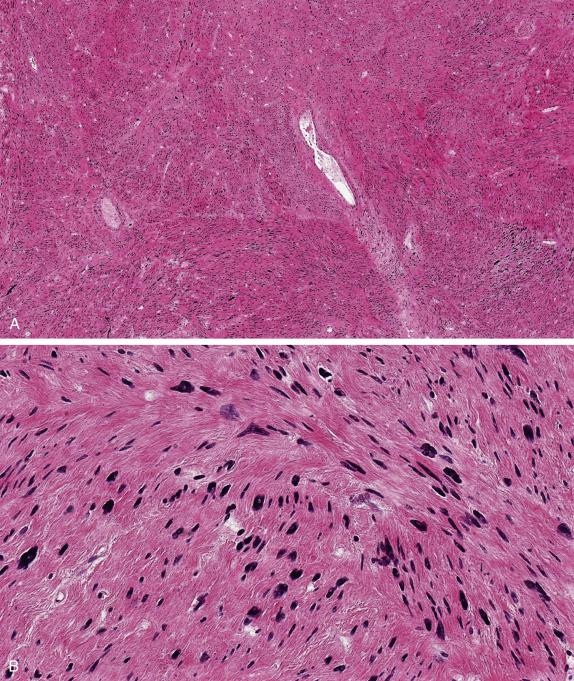
LMBNs in the context of HLRCC syndrome or abnormal FH/2SC expression (HLRCC-like; see later discussion) are associated with certain particular histologic features, including round bright eosinophilic cytoplasmic inclusions, nuclei containing prominent eosinophilic nucleoli surrounded by a halo, edema with an “alveolar” distribution pattern and staghorn vessels ( Fig. 11.16A,B ).
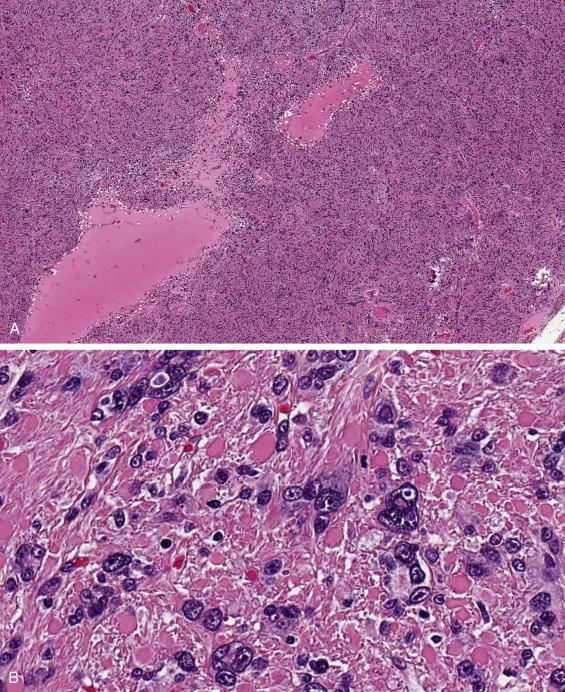
LMBN expresses smooth muscle markers and hormone receptors. Abnormal p53 staining can be seen. LMBNs with FH mutations (either germline in the context of HLRCC syndrome, or somatic) exhibit loss of FH (due to inactivating mutations) and positivity for 2SC (due to abnormal accumulation) by immunohistochemistry. Unfortunately, the latter marker is not available for routine use.
The clinical and morphologic similarities between LMBN and conventional leiomyoma contrast with the differences in their genomic profile. LMBN often has a high index of copy number variations, resulting in a high (>10) genomic index by comprehensive genomic hybridization (similar to leiomyosarcoma). Furthermore, miRNA profiling has shown a closer resemblance of LMBN to STUMP and leiomyosarcoma than leiomyoma. Recent comprehensive analysis has shown that LMBN can be divided in two groups: one with abnormal FH/2SC expression abnormalities and FH mutations, which correlate with HLRCC-like morphology (staghorn vasculature in particular), and a second with normal FH/2SC results, absence of FH mutations, and higher prevalence of TP53 and/or RB1 alterations.
The distinction between LMBN and uterine leiomyosarcoma can be challenging, particularly in tumors with diffuse bizarre cells and in fragmented or partial excision specimens. Extensive tissue sampling is required to exclude significant mitotic activity and geographic tumor cell necrosis. If the tumor has only been partially resected or completeness of the excision cannot be guaranteed, it may be not possible to establish a definitive diagnosis, as features of malignancy can be focal and diagnostic areas may not be present in the specimen. In this scenario, a diagnosis of “smooth muscle neoplasm with atypia” is prudent with an explanatory note.
LMBNs are currently regarded as benign tumors, with no recurrences or adverse patient outcomes in the largest series published to date, even in patients managed only with myomectomy. However, one study reported a low (<2%) rate of extrauterine tumor recurrence. Thus, hysterectomy or, alternatively, myomectomy accompanied by long-term clinical follow-up constitutes appropriate treatment. Recognition of morphologic features associated with FH loss and HLRCC syndrome is clinically important, as patients may undergo genetic counseling testing for germline FH mutations, ultimately leading to long-term follow-up and early detection of a potential renal cell carcinoma.
Benign smooth muscle tumor with nuclear atypia
Rare
Mean age 45 years
Abnormal uterine bleeding, pelvic mass
Patients with HLRCC syndrome are younger (second to third decade) and present with multiple cutaneous and uterine leiomyomas.
Regarded as benign (extrauterine spread rate <2%)
Managed with hysterectomy or myomectomy + surveillance
Referral to genetics counseling and testing for patients with LMBN morphologic features related to HLRCC syndrome (leiomyoma precedes emergence of renal cell carcinoma and can act as a sentinel event)
Similar to conventional leiomyoma
May have soft, yellow appearance, hemorrhage and cavitation
Atypical/bizarre cells: nuclear enlargement, irregular nuclear contour, multinucleation, hyperchromasia or coarse chromatin, prominent nucleoli
Distribution of bizarre cells: diffuse (30%), multifocal (44%), focal (26%)
Features associated with HLRCC or somatic FH mutations:
Round eosinophilic cytoplasmic inclusions
Nuclei with prominent eosinophilic nucleolus surrounded by a perinucleolar halo
Alveolar-type edema
Staghorn vessels
Smooth muscle marker and hormone receptor expression
LMBN with FH mutations (germline or somatic): Loss of FH expression, 2SC positivity
Genomic index, mutation profile, and miRNA profile closer to leiomyosarcoma than leiomyoma
Two major subgroups:
FH/2SC abnormal: FH inactivating mutations
FH/2SC normal: TP53 and RB1 alterations
Uterine leiomyosarcoma
Uterine leiomyoma
Leiomyosarcoma is relatively uncommon, comprising only 1%–2% of all uterine malignancies. Nevertheless, it is the most frequent sarcoma of the female genital tract, representing >50% of uterine sarcomas. Its low prevalence contrasts with the high occurrence of uterine leiomyoma, which only in exceedingly rare instances have been documented to progress to malignancy. Because of this, it is believed that the cellular precursor and pathogenic mechanisms of leiomyosarcoma are independent from conventional leiomyoma.
Leiomyosarcoma is more frequent in late reproductive and postmenopausal women, with a mean age of 50 years at presentation. These tumors become invariably symptomatic given their rapid growth, causing abnormal/postmenopausal bleeding, abdominal distention, pelvic pain or pressure, as well as weight loss and other constitutional symptoms. The latter is more common in patients with advanced stage at presentation, which comprise one-third of all affected women. In some cases, previous history of pelvic radiation or tamoxifen use is noted. In rare occasions, the tumor secretes parathyroid hormone–related protein, which causes secondary hypercalcemia, eosinophilia, and secondary amyloidosis. Some patients may have a prior history of radiation therapy or tamoxifen treatment. Clinical examination reveals an enlarged uterus, sometimes protruding though the cervix or effacing it. Diagnostic imaging is useful to determine the size and extent of the tumor, which often appears as a heterogeneous and irregularly contoured mass. Magnetic resonance (MR) is more specific in distinguishing leiomyoma with degenerative changes from leiomyosarcoma.
Leiomyosarcoma of the uterus is often large and bulky, with an average size of 10 cm. The tumor is usually solitary, seen as an isolated uterine lesion or less commonly in a background of smaller, conventional leiomyomas. The tumor contour can be smooth, but it is more often irregular or multinodular and difficult to separate from the adjacent wall (in contrast to leiomyoma, which is easily shelled out). Upon sectioning, leiomyosarcoma is heterogeneous, with rubbery tan foci alternating with softer, yellow areas as well as hemorrhage, necrosis, and pseudocystic cavitation ( Fig. 11.17 ). Epithelioid leiomyosarcomas can be predominantly or exclusively soft and yellow. Myxoid leiomyosarcoma is typically irregular and infiltrative, soft, tan to yellow, and gelatinous in consistency.
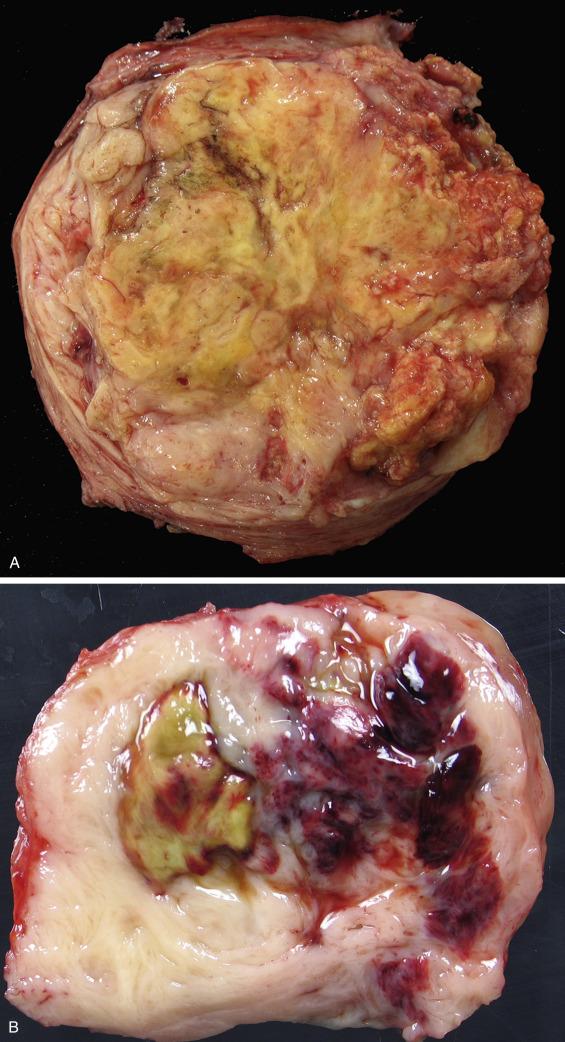
Leiomyosarcoma of the uterus can be divided into three main morphologic types: conventional (spindle cell), epithelioid, and myxoid, although combinations can be seen. Conventional (spindle cell) leiomyosarcoma is by far the most frequent. It is characterized by high cellularity and border irregularity at low power magnification ( Fig. 11.18A ). The interface can be frankly infiltrative or less often simulate the nodular, myopermeative growth of endometrial stromal tumors. The neoplasm is composed of cells organized in fascicles and appear elongated (spindled) or round to ovoid depending on the plane of section. The tumor cell population displays at least two of the following features, which have been proven to be associated with malignant behavior:
Tumor cell necrosis: necrosis in the context of malignancy is a reflection of rapid tumor growth and genomic instability. The transition between viable and nonviable areas is sharp and lacks significant collagen deposition and inflammation that are common in ischemic change (which has a slower evolution over time, and tissue inflammation and repair are more often visualized). The resulting appearance of tumor cell necrosis is described as geographic (because the margin between viable and necrotic tissue is sharp and convoluted) ( Fig. 11.19A,B ) .
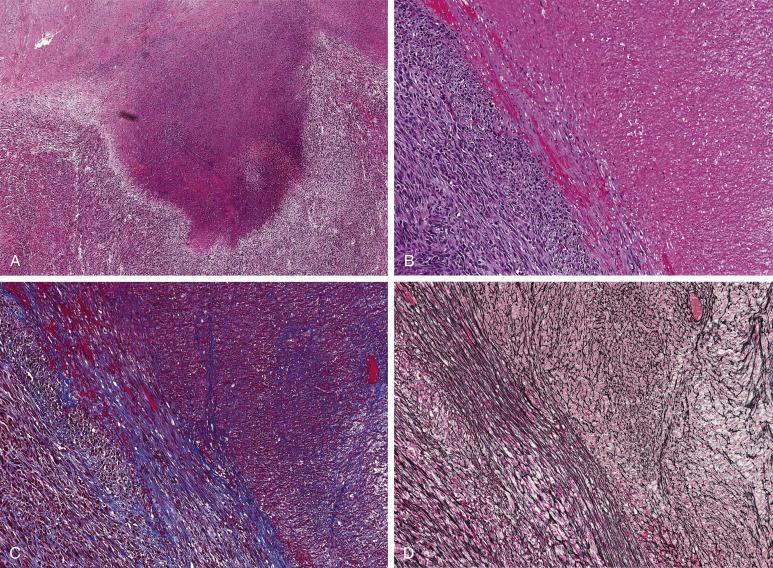
Cytologic atypia: significant atypia (moderate to severe in degree) in the context of uterine smooth muscle neoplasia requires nuclear hyperchromasia and enlargement evident at low power magnification that is multifocal to diffuse in distribution ( Fig. 11.20 ). Minimal variation in nuclear size appreciable only at high power magnification represents only mild atypia, and is not significant. Multinucleated tumor cells are present in >50% of cases.
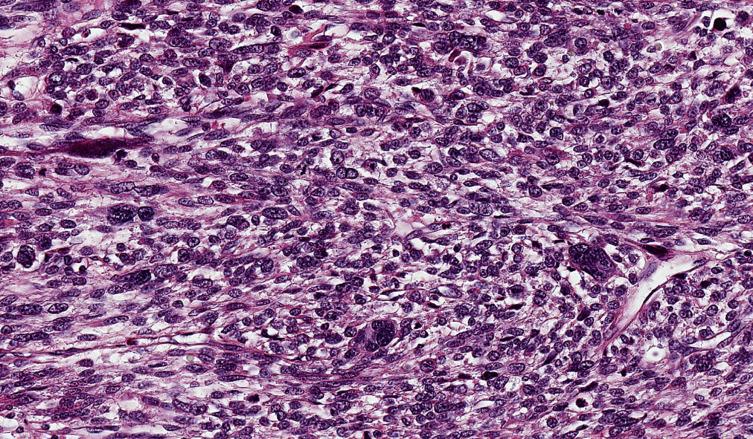
Mitotic activity: a proliferation rate of 10 or more mitoses in 10 HPFs (400× magnification) is regarded as indicative of malignancy, if atypia and/or necrosis are also present ( Fig. 11.21A ). The mitotic count requires scanning at least 50 HPFs, choosing the areas in which proliferation appears higher, but avoiding tumor adjacent to ischemic change and hemorrhage. The highest count in 10 HPFs (“hotspot”) should be taken as the final count. The presence of atypical mitotic figures should be noted, as they also suggest malignancy. It is important to identify apoptosis, inflammatory cells, and karyorrhectic debris; misclassification of these as mitotic figures will result in overestimation of proliferation and, potentially, in misdiagnosis of malignancy ( Fig. 11.21B ).
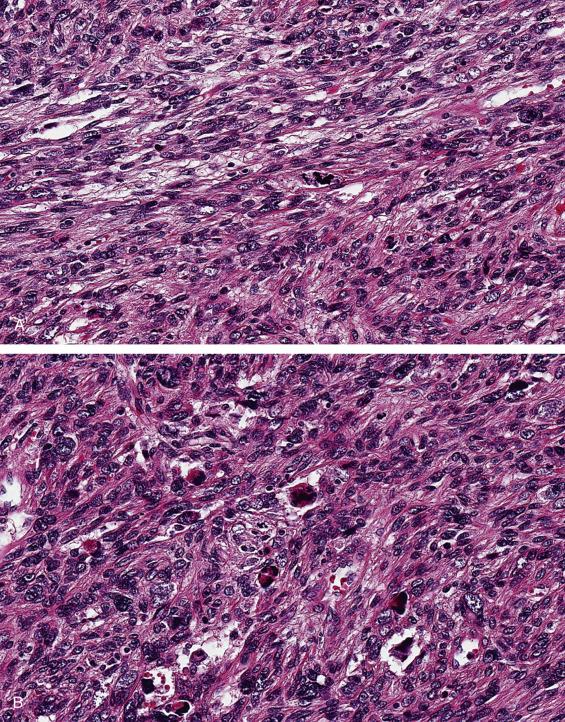
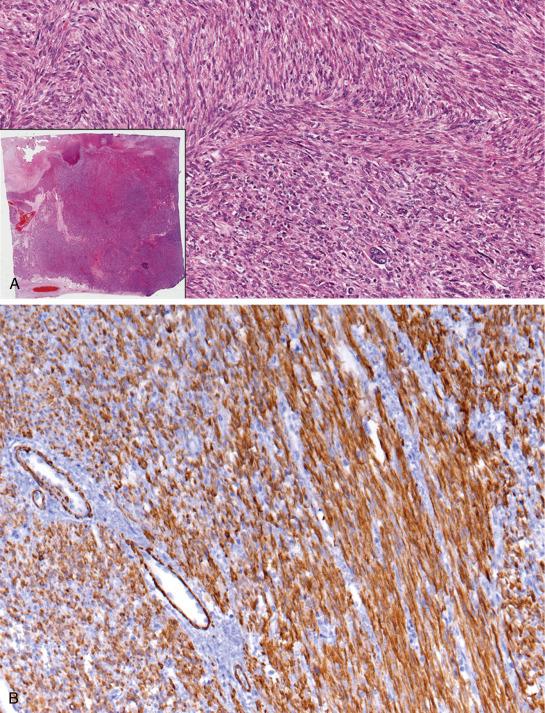
Lymphatic and venous vascular invasion is identified in approximately 20% of leiomyosarcomas; occasionally, the intravascular growth exceeds in volume that of the intramural mass itself. Histologic grade of uterine leiomyosarcoma lacks established definitions and correlation with outcome and therefore is not performed; instead, all tumors are inherently considered “high grade” when they show significant cytologic atypia (defining feature as described previously).
Epithelioid leiomyosarcoma is a tumor with significant (≥50%) epithelioid cell morphology, characterized by polygonal to ovoid cells with eosinophilic (or, less often, clear) cytoplasm and central round hyperchromatic nuclei ( Fig. 11.22A ). Vacuolation with nuclear displacement occurs rarely, imparting a lipoblast-like appearance. Hyalinization with a plexiform pattern can be encountered. Definitions for cytologic atypia and tumor cell necrosis in conventional leiomyosarcoma also apply for the epithelioid variant. However, in contrast to spindled leiomyosarcoma, low mitotic counts have been associated with malignant behavior. A threshold of 5 or more mitoses/10 HPFs is accepted by most authors for this epithelioid variant. Thus, the presence of necrosis or ≥5 mitoses/10 HPFs with or without cytologic atypia, warrants a diagnosis of epithelioid leiomyosarcoma. It is important to note that, given the rarity of this tumor subset, the proposed criteria and definitions for malignancy are not well established and require further validation.
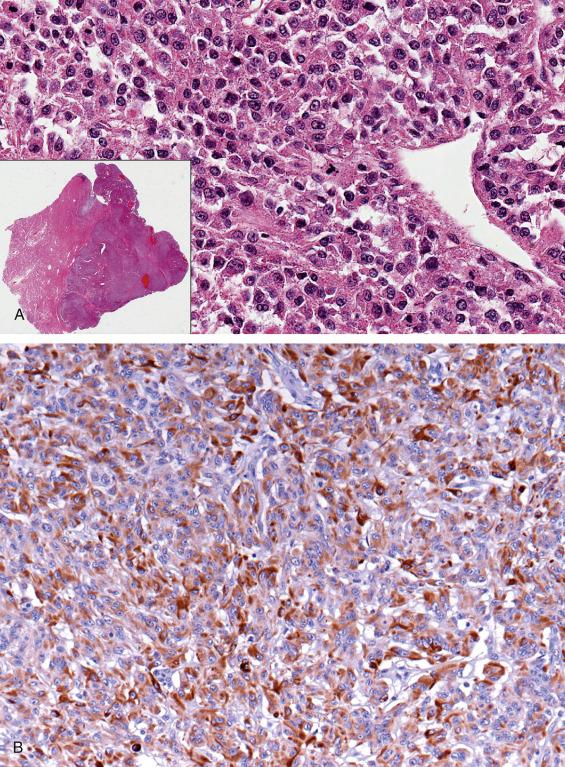
Myxoid leiomyosarcoma is also rare; by definition, the myxoid matrix occupies a significant proportion of the tumor volume ( Fig. 11.23A ). It has been hypothesized that the abundant myxoid matrix, rich in glycosaminoglycans, dissects fascicles and separates tumor cells, resulting in lower cellularity and “diluted” mitotic counts ( Fig. 11.23B ). Indeed, myxoid smooth muscle tumors with as little as 2 mitoses/10 HPFs have been associated with malignant course. Moreover, nuclear atypia can be mild and focal. Despite the abundance of myxoid matrix deposition, the tumor retains (at least focally) a fascicular arrangement, and the nuclei display the hyperchromasia and tapered ends seen in conventional tumors. The most consistent feature of uterine myxoid smooth muscle neoplasms with adverse outcomes is the presence of an infiltrative tumor border. Therefore, the diagnosis of myxoid leiomyosarcoma is warranted if the tumor has at least two of the following: infiltrative / invasive edge, moderate or severe atypia, ≥2 mitoses/10 HPFs or tumor cell necrosis. As with epithelioid tumors, the experience with myxoid leiomyosarcoma is limited, and further validation of these criteria is necessary.
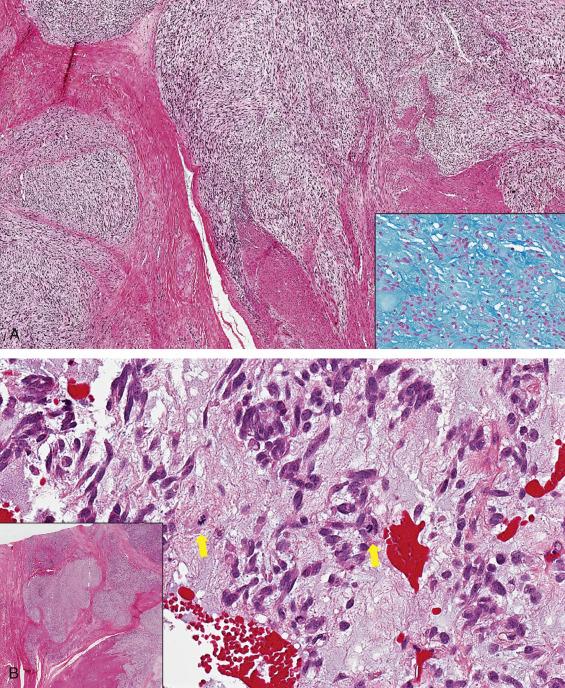
Trichrome and reticulin stains may be useful in the distinction between coagulative and ischemic-type necrosis. In coagulative (geographic) necrosis, there is minimal to no collagen deposition in devitalized areas compared to viable areas, and the necrotic tissue stains red with trichrome stain (instead of blue, which highlights collagen). Moreover, the pericellular reticulin network is retained in necrotic tumor areas ( Fig. 11.19C,D ). As mentioned previously, Alcian blue stain at pH 2.5 is useful to highlight myxoid stroma ( Fig. 11.23B , inset).
Leiomyosarcoma is positive for SMA, desmin, smooth muscle myosin, and caldesmon ( Fig. 11.18B ). Importantly, myxoid and epithelioid types tend to show less intense positivity than conventional lesions. ER and PR are expressed in most (>90%) uterine leiomyosarcomas; whereas AR is less frequent. CD10 is positive in up to 30% of tumors ( Fig. 11.18C ). C-KIT can also be positive. Keratin and EMA staining may be observed and is more common in epithelioid tumors ( Fig. 11.22B ). ALK is negative in most cases. Abnormal p53 staining (overexpression or complete absence) and p16 overexpression have been documented in ∼50% leiomyosarcomas (conventional and myxoid). Ki67 proliferation index is usually high (>10%) in conventional leiomyosarcoma, but not always in epithelioid and myxoid variants.
Unlike leiomyoma, which has absent or at most simple karyotypic aberrations, leiomyosarcoma is frequently aneuploid with a complex karyotype. The most frequent abnormalities include gain of 1q, 17p, and Xp and loss of heterozygosity of 10q (which involves the PTEN gene) and 13q (involving the RB1 gene). The most commonly mutated genes are TP53 (65%) and VIPR2 (92%). VIPR2 deletions have been associated with poor outcome. Alterations in ATRX and DAXX , which are involved in alternative lengthening of telomeres, have been described in ∼80% of uterine leiomyosarcomas. MED12 mutations are not frequent (∼10%) and differ from those found in leiomyomas (being more frequently truncating instead of hotspot).
Recently, molecular grouping of uterine leiomyosarcoma by gene expression profiling results in two groups: one resembling normal smooth muscle (with overexpression of genes related to smooth muscle function, such as LMOD1 , SLMAP , MYLK , and MYH11 ; associated with morphology in the lower end of the spectrum and good response to chemotherapy) and one with upregulation of epithelial to mesenchymal transition and other oncogenic pathways (including CDK6 , MAPK13 , and HOXA1 upregulation; associated with more overt pleomorphism, invasion and proliferation, and less response to chemotherapy). In addition, it has been shown that clinically malignant smooth muscle tumors have a high genomic index (calculated based on the amount of global copy number variations); in contrast, indolent tumors had a genomic index less than 10 (in keeping with the lack of copy number gains and losses). These findings may open the door to the integration of molecular testing in the diagnosis and prognostic stratification of uterine smooth muscle tumors.
Regarding myxoid leiomyosarcoma, the spectrum of molecular alterations is largely unknown. This tumor type is negative for ALK rearrangements. TP53 and CDK2N mutations have been reported in ∼50 cases. Molecular alterations of epithelioid leiomyosarcoma have not been yet described.
When considering the diagnosis of leiomyosarcoma, distinction from leiomyoma variants is crucial. As discussed previously, these variants are characterized by the presence of one feature worrisome for malignancy (i.e., nuclear atypia, increased mitoses, myopermeative infiltration, high cellularity, and epithelioid or myxoid morphology) but, importantly, lack all the other features diagnostic of leiomyosarcoma. The exception to this rule is geographic tumor cell necrosis, which even in isolation is a worrisome finding and is associated with tumor recurrence; thus, when encountered, additional sampling may be required to identify atypia and/or increased mitoses. In their absence, the diagnosis of uterine smooth muscle tumor of uncertain malignant potential (STUMP) is recommended. However, it is important to keep in mind that the interobserver reproducibility even among expert gynecologic pathologists in the distinction between coagulative and ischemic necrosis is at best fair; thus, caution is suggested in solely relying on necrosis as a criterion for malignancy. Other instances of diagnostic difficulty between leiomyoma and leiomyosarcoma will also default to the use of the term STUMP (see corresponding section further in this chapter). Ki67, p16, and p53 have been used in the distinction between benign and malignant smooth muscle tumors. High Ki67 index, as well as abnormal p53 and p16 expression patterns, may be of value, although in the absence of unequivocal morphology of leiomyosarcoma their significance is unclear, and thus caution is advised.
Leiomyosarcoma also requires distinction from other mesenchymal proliferations, including rhabdomyosarcoma (rare, characterized by highly atypical, pleomorphic cells with rhabdoid morphology, including densely eosinophilic round inclusions and cross-striations, and expression of myogenin and MyoD1), endometrial stromal sarcoma (with typical finger-like myometrial infiltration, a less prominent degree of nuclear atypia, and lack of thick-walled vessels within the tumor; negative smooth muscle markers and frequent positivity for specific recurrent gene rearrangements), and undifferentiated uterine sarcoma (highly pleomorphic population with lack of fascicular growth and smooth muscle morphology; negative smooth muscle markers). Carcinosarcoma is also an important consideration, as sometimes the carcinomatous component is minor and vastly outweighed by the sarcomatous component (which may have features of leiomyosarcoma). The identification of a high-grade carcinoma component with an evident “biphasic” separation from the sarcomatous proliferation will suffice to solve this differential, but it may require extensive sampling and correlation with previous biopsy material. Gastrointestinal stromal tumor may rarely involve the uterus (secondarily) but may pose great difficulty in its distinction from a smooth muscle neoplasm. C-KIT and DOG-1 are helpful if negative; however, staining for these markers has been reported in leiomyosarcoma, and molecular testing for C-KIT mutations may be necessary. A high index of suspicion is required, especially if the mass involves the intestine or has unclear anatomic origin on clinical and radiologic examination.
Epithelioid leiomyosarcoma may require distinction from a poorly differentiated endometrial carcinoma , which most of the time has areas of glandular, papillary, and/or squamous differentiation. If immunohistochemistry is needed, it is important to note that epithelioid leiomyosarcomas are often positive for keratin and EMA, and a panel of smooth muscle markers need to be included. Perivascular epithelioid tumor (PEComa) greatly overlaps with leiomyosarcoma of the conventional and epithelioid types. The presence of clear or granular (instead of eosinophilic) cytoplasm and striking perivascular cell aggregation should raise this possibility. Expression of HMB45, Melan-A, microphthalmia transcription factor (MITF) and cathepsin-K is more in keeping with PEComa. Like with epithelioid leiomyoma, placental site trophoblastic tumor and epithelioid trophoblastic tumor may mimic epithelioid leiomyosarcoma; however, these tumors are seen in younger, reproductive-age patients with a recent or remote history of pregnancy and are associated with mildly elevated HCG levels. Histologically, the presence of abundant fibrinoid deposition around cells and clusters of cells is characteristic. Immunohistochemistry for markers of intermediate trophoblast is often helpful (see Chapter 19 ).
The differential diagnosis of myxoid leiomyosarcoma includes myxoid leiomyoma (discussed previously), inflammatory myofibroblastic tumor (IMT), and endometrial stromal sarcoma. IMT is often well circumscribed and lacks the infiltrative border typical of myxoid leiomyosarcoma, although it is important to keep in mind that it can show irregular and infiltrative edges. The neoplastic population often has a characteristic “tissue culture-like” appearance with fusiform plump cells dispersed individually rather than in fascicles and admixed with inflammation. Testing for ALK immunohistochemistry and ALK rearrangements by fluorescence in situ hybridization (FISH) or sequencing is helpful, and a positive result usually confirms the diagnosis of IMT. Of note, strong ALK positivity by immunohistochemistry highly correlates with ALK rearrangements. Importantly, a negative ALK does not necessarily exclude the diagnosis. In addition, some examples of IMT may show a false-negative result by FISH if the gene involved in the rearrangement is spatially close to the ALK gene. The recently described HG-ESS with BCOR genetic alterations has a predominant fibromyxoid appearance, high mitotic counts, necrosis and myometrial infiltration. Unlike myxoid leiomyosarcoma, these tumors are negative or only weakly positive for smooth muscle markers and strongly express CD10; they also may show strong diffuse staining for BCOR and cyclin D1, but not always. Fibromyxoid LG-ESS may enter in the differential; however, fibromyxoid change is usually focal and admixed with classic low-grade endometrial stromal tumor morphology.
Leiomyosarcoma of the uterus is an aggressive neoplasm with an overall poor prognosis. The 5-year survival ranges from 15% to 65% and is stage dependent (being higher for tumors confined to the uterus). In addition to advanced stage, patient age >50 years, tumor size >5 cm, high mitotic count, vascular invasion, and incomplete surgical debulking have all been associated with worse patient outcome. High hormone receptor expression (particularly PR and AR) is associated with better prognosis. Up to 70% of patients with International Federation of Gynecology and Obstetrics (FIGO) stage I disease and almost all patients with stage II or greater will ultimately suffer local or distant recurrence, usually within the first 18 months. Distant tumor spread is hematogenous (much less likely through lymphatics), and the lung is the most common distant site involved, followed by liver and brain.
The prognosis of myxoid leiomyosarcoma, based on limited series, appears to be worse than conventional leiomyosarcoma. This variant is associated with frequent and rapid tumor recurrence and progression. The prognostic significance of epithelioid leiomyosarcoma is not fully elucidated, although late recurrences (more than 5–10 years after diagnosis) have been reported.
The management of leiomyosarcoma is primarily surgical (total hysterectomy, bilateral salpingo-oophorectomy, and debulking of macroscopic disease). Since the diagnosis may not be confirmed or highly suspected preoperatively, intraoperative consultation may be requested. Nodal dissection and staging biopsy have no definitive role in leiomyosarcoma. Systemic treatment with chemotherapy and radiation can be considered in patients with recurrent of unresectable disease; unfortunately, the impact on survival is minimal, if any. Hormonal treatment with aromatase inhibitors is also an alternative. Targeted therapy with mTOR inhibitors may be of benefit in some cases.
Malignant smooth muscle tumor of uterus
1%–2% of all uterine malignancies
Most frequent gynecologic tract sarcoma (>50% of all uterine sarcomas)
Mean age 60 years (perimenopausal and postmenopausal women)
Increased incidence among black women
Abnormal vaginal bleeding
Abdominal distention, pelvic pain or pressure
Constitutional symptoms
Occasionally hypercalcemia and eosinophilia
Rarely, prior history of radiation therapy or tamoxifen treatment
5-year survival rate of 15%–65% depending on stage (better in stage I disease)
Stage is strongest prognosticator
Other prognostic factors: age, tumor size, vascular invasion, completeness of debulking
Recurrence rate of ∼70% for stages I and II and almost 100% for stages III and IV (within 18 months)
Hematogenous spread to lung, liver over lymphatic spread
Myxoid leiomyosarcoma appears to have worse survival compared to conventional
Epithelioid leiomyosarcoma can have late recurrences (>10 years)
Treatment includes hysterectomy, bilateral salpingo-oophorectomy, and debulking
Systemic therapy if recurrent or advanced-stage disease; poor response
Hormonal therapy if progressing disease
The term smooth muscle tumor of unknown / uncertain malignant potential (STUMP), rather than a distinct diagnostic entity, encompasses a variety of uterine smooth muscle tumors in which current histopathologic criteria and ancillary tools do not permit categorization as benign or malignant. Every effort should be made to provide a more definitive diagnosis through proper sampling and careful microscopic examination.
Age distribution is not significantly different from patients with leiomyosarcoma, with a mean age of 45–50 years (range 24–85 years). Most STUMPs clinically present as a pelvic mass presumed to be a fibroid on clinical and radiologic examination. In a minority, suspicious features like irregular contour, necrosis, or hemorrhage are recorded.
Tumors classified as STUMP vary in size. Most are grossly indistinguishable from a leiomyoma.
As a diagnostic category, the definitions of STUMP vary among publications (and, likely, among practices). This diagnosis should be considered in the following scenarios:
Significant cytologic atypia and mitotic activity approaching the threshold for malignancy (in the order of 8–9 mitoses/10 HPFs) in the absence of necrosis ( Fig. 11.24 ). It is recommended to expand the search for mitotic figures to more than 50 HPFs and to perform extensive sampling (at least one section per centimeter of the tumor greatest dimension). The recurrence rate of published cases in this scenario is 11.2%.
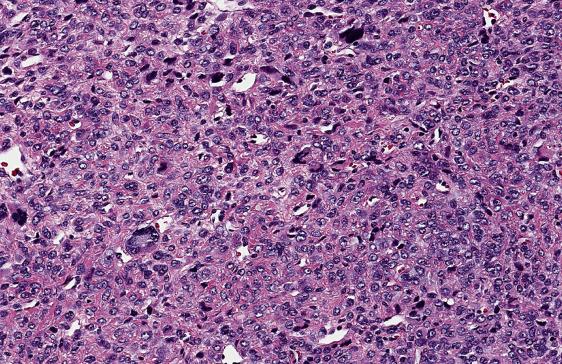
Unequivocal coagulative tumor cell necrosis with no significant atypia and <10 mitoses/10 HPFs. This is a very rare scenario. The recurrence rate of tumors with these features is higher than in other STUMP scenarios (26.7%), and some consider necrosis as a sole criterion sufficient for the diagnosis of leiomyosarcoma; however, the reader is cautioned that the reproducibility for recognizing coagulative tumor cell necrosis is low.
Tumor cell necrosis that is difficult to classify (ischemic versus coagulative). Since tumors with unequivocal coagulative necrosis can recur, the diagnosis of STUMP is warranted if the possibility of coagulative necrosis cannot be confidently excluded.
Large mass (mean 10 cm)
Solitary or dominant
Poorly circumscribed
Heterogeneous, soft and fleshy cut surface
Frequent necrosis and hemorrhage
Epithelioid and myxoid variants: soft, yellow and gelatinous (if myxoid) cut surface
High grade by definition
Irregular, infiltrative growth
Hypercellular lesion composed of intersecting fascicles
Elongated nuclei with tapered ends (“cigar” shape)
Morphologic criteria for malignancy (at least two):
Significant cytologic atypia: moderate or severe, multifocal to diffuse; enlarged hyperchromatic nuclei with coarse chromatin and irregular nuclear membranes
Coagulative tumor cell necrosis: sharp demarcation (“geographic”)
Mitotic activity ≥10 mitoses/10 HPFs: count at least 50 HPFs, choose highest count in 10 fields (disregard apoptosis, karyorrhexis and equivocal figures)
Vascular invasion in 20%
≥50% of cells with epithelioid appearance (polygonal eosinophilic cytoplasm, central ovoid nucleus)
Sheets, nests, cords, or trabeculae; rarely pseudoglandular spaces
Central hyalinization common
Significant cytologic atypia (as defined for conventional tumors) may be present
Morphologic criteria for malignancy (any of following):
Coagulative tumor cell necrosis
Mitotic rate ≥5 mitoses/10 HPFs
Prominent myxoid extracellular matrix
Myxoid matrix separates fascicles and tumor cells, imparting hypocellular appearance
Mitotic activity and nuclear atypia may be subtle or absent
Fusiform hyperchromatic nuclei
Morphologic criteria for malignancy (at least two):
Infiltrative tumor border, cell necrosis, cytologic atypia or ≥2 mitoses/10 HPFs
Coagulative tumor cell necrosis lacks collagen deposition and retains pericellular reticulin network
Alcian blue pH 2.5 highlights myxoid matrix
SMA, desmin, caldesmon, smooth muscle myosin positive (strong and diffuse in conventional, less in epithelioid and myxoid variants)
Estrogen, progesterone, and androgen receptors often positive
CD10 and C-KIT can be positive
Keratin and EMA variably positive (more frequent in epithelioid variant)
Abnormal p53 staining and p16 overexpression (∼50%)
High Ki67 index (>10%)
Frequent complex karyotypic chromosomal aberrations
TP53 and VIPR2 frequently mutated (also RB1 , PTEN )
Molecular subgrouping by gene expression profiling and genomic index (based on copy number variation burden)
Absence of C-KIT mutations and ALK rearrangements
Leiomyoma variants
Pleomorphic rhabdomyosarcoma
Low-grade endometrial stromal sarcoma
High-grade endometrial stromal sarcoma
Undifferentiated endometrial sarcoma
Carcinosarcoma
Gastrointestinal stromal tumor
Endometrial carcinoma (endometrioid, serous)
Perivascular epithelioid cell tumor
Placental site trophoblastic tumor
Epithelioid trophoblastic tumor
Inflammatory myofibroblastic tumor
Mitotic activity exceeding 15 mitoses/10 HPFs, in the absence of significant atypia and necrosis. Although no reported cases in this category recurred, experience is limited, and long-term follow-up is advisable.
Epithelioid smooth muscle tumors with significant cytologic atypia, but with no necrosis and <5 mitoses/10 HPFs. Also, in the context of a tumor with 5–10 mitoses/10 HPFs and/or cytologic atypia, if epithelioid features are either equivocal or present approaching 50% of the tumor, the diagnosis of epithelioid STUMP should be considered.
Myxoid smooth muscle tumors with irregular borders but no other malignant feature, and tumors with well-defined borders and one of the following: atypia, ≥2 mitoses/10 HPFs, or necrosis. There is not enough experience in the literature in this scenario; thus, the default to STUMP is suggested. Likewise, if the presence of myxoid change is suspected but cannot be confirmed in a tumor with atypia and/or 2–10 mitoses/10 HPFs, the diagnosis of STUMP can be considered.
Additional characteristics have been recently suggested. They, when seen in isolation, should warrant consideration for the diagnosis of STUMP. These include atypical mitoses, vascular involvement, and infiltrative margins.
A final diagnosis of STUMP can be made only on hysterectomy and occasionally in myomectomies that are received intact and in which completeness of excision can be assured (which is difficult and rare from the pathology standpoint). Smooth muscle tumors falling into one of the “grey zones” outlined previously in curettage, morcellation, and other fragmented myomectomy specimens should be reported as “smooth muscle neoplasm of at least unknown malignant potential.”
STUMPs have the same immunoprofile of leiomyomas. The expression of Ki67, p53, and p16 is variable and often not contributory.
About 11% of STUMPs harbor MED12 mutations, much less often than leiomyomas and closer to the reported prevalence in leiomyosarcomas. It has been shown that tumors classified morphologically as STUMP can be classified using the genomic index, calculated based on the number of copy number variations detected by comparative genomic hybridization. The genomic index (with a threshold of 10) separated tumors with indolent outcome from those with recurrence and unfavorable outcome.
The smooth muscle nature of STUMPs is evident in most cases, and the diagnostic difficulty lies in the determination of risk (and thus the benign or malignant nature of the lesion). If the tumor displays epithelioid morphology, perivascular epithelioid cell tumor and other epithelioid lesions (e.g., carcinoma) are in the differential. In the setting of a tumor with myxoid features, IMT must be considered. In fact, it was recently demonstrated that a subset of STUMPs, all with myxoid features, harbored ALK rearrangements and ALK immunohistochemical expression and hence represented IMTs.
Most STUMPs are diagnosed at the time of hysterectomy, after which management includes close and long-term follow-up. If the possibility of STUMP is raised by other sampling methods, hysterectomy should be considered or at least careful clinical and radiologic monitoring. The recurrence rate of published series of STUMP in the literature varies from 7% to 26.7%, although a recent series documented a recurrence rate of 36.4%. This series included tumors with atypical mitoses, vascular invasion, and infiltrative borders, suggesting that a larger spectrum of smooth muscle tumors may benefit from clinical surveillance. In some cases, the morphology of the recurrence fulfills pathologic criteria for leiomyosarcoma, but in most, the incomplete or equivocal characteristics remains; nevertheless, tumor recurrence by itself is a sign of aggressiveness, and some postulate that these lesions represent a “low-grade” leiomyosarcoma. Although making this diagnosis once the tumor has declared itself biologically is permissible, the existence of low-grade leiomyosarcoma of the uterus as a diagnostic category requires further investigation.
Uterine smooth muscle tumors that cannot be confidently classified as benign or malignant
Rare
Mean age 45–50 years
Similar to leiomyoma
Occasionally, rapid growth or worrisome imaging findings
Overall recurrence rate 7%–36%
Hysterectomy is treatment of choice, followed by long-term surveillance
Patients not undergoing hysterectomy should be closely followed
Similar to leiomyoma
Significant cytologic atypia (multifocal or diffuse) and 8-9 mitoses per 10 HPFs
Coagulative tumor cell necrosis as sole finding
Tumors in which coagulative necrosis is suspected, but not confirmed
Mitotic activity >15 mitoses/10 HPFs
Epithelioid tumor with significant atypia; equivocal epithelioid features
Myxoid tumors with only one feature of the following: atypia, ≥2 mitoses/10 HPFs, or necrosis; equivocal for myxoid change
MED12 mutations are infrequent (11%).
Genomic index stratifies patients into prognostic groups (based on copy number variation burden)
Leiomyoma
Leiomyosarcoma
Perivascular epithelioid cell tumor
Inflammatory myofibroblastic tumor
The phenomenon of uterine leiomyoma with extrauterine spread is exceedingly rare but well documented, which defies our current concepts of benign and malignant tumor behavior. The following categories have been described: intravenous leiomyomatosis, benign metastasizing leiomyoma, and disseminated intraperitoneal leiomyomatosis. The latter is, in most cases, an independent primary peritoneal process and is discussed in Chapter 18 . A clonal relationship between a uterine leiomyoma and the extrauterine tumor has been suggested in cases of intravenous leiomyomatosis and benign metastasizing leiomyoma.
Intravenous leiomyomatosis is usually an incidental finding on hysterectomy performed for “fibroids”. In some instances, symptoms and signs of venous occlusion and insufficiency are present. Imaging may show multiple nodules occupying vascular spaces in the uterus, pelvis and abdominal cavities; even extension to the inferior vena cava, right atrium of the heart, and superior vena cava has been reported. Benign metastasizing leiomyoma presents as a mass, typically in the lung, in a patient with previous history of uterine leiomyomas (sometimes years ago) or rarely with a recent or concurrent finding of uterine fibroids. Other less common sites of involvement are the retroperitoneum, pelvic lymph nodes, liver and bone.
Intravenous leiomyomatosis is characterized by numerous well-defined nodules with firm consistency and whorled appearance filling dilated vascular channels. The nodularities often acquire the shape of the vessel and become elongated and tortuous (worm-like). A leiomyoma is not identified, or if present, is anatomically separate from the intravascular lesions. Benign metastasizing leiomyoma is usually a small (<10 cm) smooth and round lesion embedded in the organ affected (usually the periphery of the lung). Lesions are often multiple.
Intravenous leiomyomatosis : The tumors protrude into vascular channels, often with complete or near-complete occlusion; tumor plugs are covered by bland endothelium ( Fig. 11.25A,B ). Immunohistochemistry for endothelial markers may be required for confirmation. The tumor is otherwise identical to an intramural leiomyoma or leiomyoma variant. The lesions are predominantly or completely intravascular, although some attachment to the wall may be observed. However, the intravascular tumor is not solely within a leiomyoma; if a leiomyoma is seen, it is separate from the intravascular lesions.
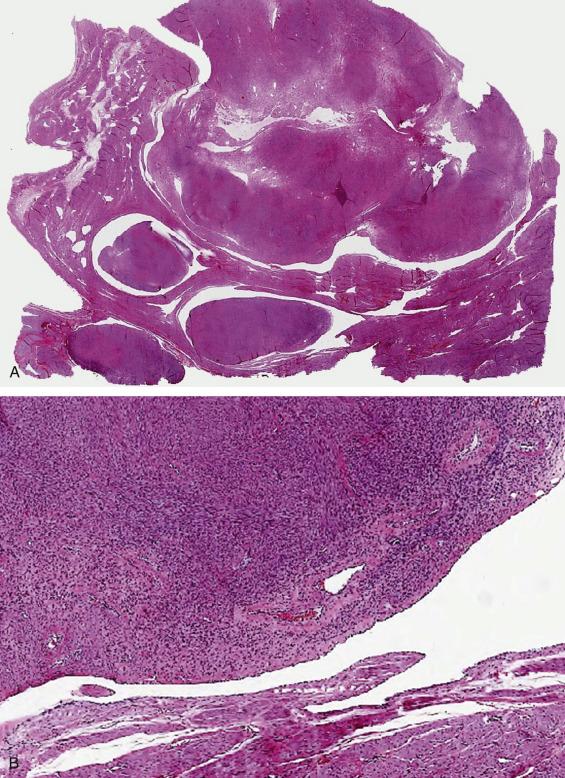
Benign metastasizing leiomyoma: The metastatic lesion is morphologically identical to a conventional banal-appearing leiomyoma, although some may be cellular. Extensive or complete sampling is required to exclude features worrisome for malignancy.
Intravenous leiomyomatosis has been associated with t(12;14)(q14.3;q24), which involves the HMGA2 gene. Cytogenetic analysis of cases of benign metastasizing leiomyoma has shown deletions of 19q and 22q, which are not common in uterine leiomyoma and may suggest an independent origin. However, allelic imbalance and chromosome X inactivation patterns highly mirroring uterine leiomyoma have also been documented, suggesting metastasis from a single clone.
Intravenous leiomyomatosis is distinguished from leiomyoma with intravascular intrusion by the absence of a contiguous intramural leiomyoma connected to the vascular tumors. Intravenous leiomyomatosis featuring high cellularity requires distinction from a LG-ESS ; extensive sampling, attention to the vasculature of the lesion (which tends to show larger, thick walled vessels in IVL as opposed to smaller spiral arteriole-like vessels in ESS), and use of smooth muscle immunohistochemical markers (which are diffusely positive in IVL but only positive in areas of smooth muscle differentiation in ESS) are helpful in this scenario. In the context of an extrauterine smooth muscle tumor in which the phenomenon of benign metastasizing leiomyoma is being considered, the possibility of leiomyosarcoma should be excluded first. Careful pathologic examination and review of previous histologic material corresponding to the uterine leiomyoma are helpful. Primary pulmonary lesions entering in the differential diagnosis include primary leiomyoma , pulmonary hamartoma , and lymphangioleiomyomatosis . The latter, although featuring a prominent smooth muscle component, also contains a lymphatic-type vascular proliferation and HMB45 expression.
Intravenous leiomyomatosis requires hysterectomy and bilateral salpingo-oophorectomy, the latter to prevent tumor regrowth given that this tumor is hormone sensitive. Resection of disease within vascular spaces outside of the uterus can be challenging, particularly if involvement extends beyond the pelvis. Prognosis is excellent, although pelvic and cardiac recurrences have been reported. Resection of the metastatic lesion in benign metastasizing leiomyoma is usually sufficient , however, some patients have miliary type disease and complete resection is not possible; hormonal treatment may be considered to prevent or diminish tumor growth.
Intravenous leiomyomatosis: intravascular proliferation of benign smooth muscle within the uterus +/- extrauterine sites
Benign metastasizing leiomyoma: banal smooth muscle proliferation in extrauterine location, most often lung
Exceedingly rare
Intravenous leiomyomatosis: uterine enlargement by multiple nodules, some with extension into parametrial, pelvic, abdominal or thoracic veins
Benign metastasizing leiomyoma: well-defined mass in lung, lymph nodes, retroperitoneum, liver, or bone; patient often with history (usually remote) of uterine leiomyoma(s)
Indolent outcome after resection
Pelvic or cardiac recurrences up to 15 years later in intravenous leiomyomatosis
Salpingo-oophorectomy and hormonal treatment often considered to prevent or slow tumor regrowth
Intravenous leiomyomatosis: multiple nodules occupying vascular spaces and acquiring shape of vessel (worm like). Anatomically separate or no associated leiomyoma.
Benign metastasizing leiomyoma: well-defined firm, white whorled nodule, with bulging cut surface
Intravenous leiomyomatosis: benign smooth muscle nodules occupying vascular channels and covered by endothelium. Intramural leiomyoma absent or anatomically separate
Benign metastasizing leiomyoma: conventional or cellular smooth muscle morphology
Intravenous leiomyomatosis: t(12;14)(q14c;q24)
Benign metastasizing leiomyoma: deletions of 19q and 22q
Intravenous leiomyomatosis:
Leiomyoma with intravascular intrusion
Low-grade endometrial stromal sarcoma
Benign metastasizing leiomyoma:
Leiomyosarcoma
Primary pulmonary leiomyoma
Pulmonary hamartoma
Lymphangioleiomyomatosis
Despite being the second most common mesenchymal tumor category in the uterus, neoplasms of endometrial stromal derivation only account for less than 10% of all tumors. Their classification has evolved in the last few decades, removing and then reinstating the category of HG-ESS, which are now defined by their molecular alterations. Among the spectrum of low-grade tumors, ESN and LG-ESS have significant morphologic, immunophenotypic, and molecular overlap.
This rare tumor is defined by its low-grade endometrial stromal morphology, absent or only minimal myometrial infiltration, and indolent behavior.
Endometrial stromal nodule (ESN) is more prevalent in perimenopausal women (fifth to sixth decades), with a median age of 47 years. Abnormal or postmenopausal bleeding and pelvic pain/pressure are the most common symptoms.
The tumor more often has a submucosal location and can protrude into the endometrial cavity, although it can be present anywhere within the myometrium. Tumor size varies, but most are 10 cm or less in greatest dimension (range 0.5–22, mean 7 cm). They are well demarcated, nonencapsulated lesions that, unlike leiomyomas, do not bulge upon sectioning and have a soft consistency and yellow coloration ( Fig. 11.26A ). Hemorrhage or pseudocystic change can be observed ( Fig. 11.26B ). The interface between the tumor and the surrounding myometrium needs to be carefully examined and sampled extensively or entirely to exclude myoinvasion.
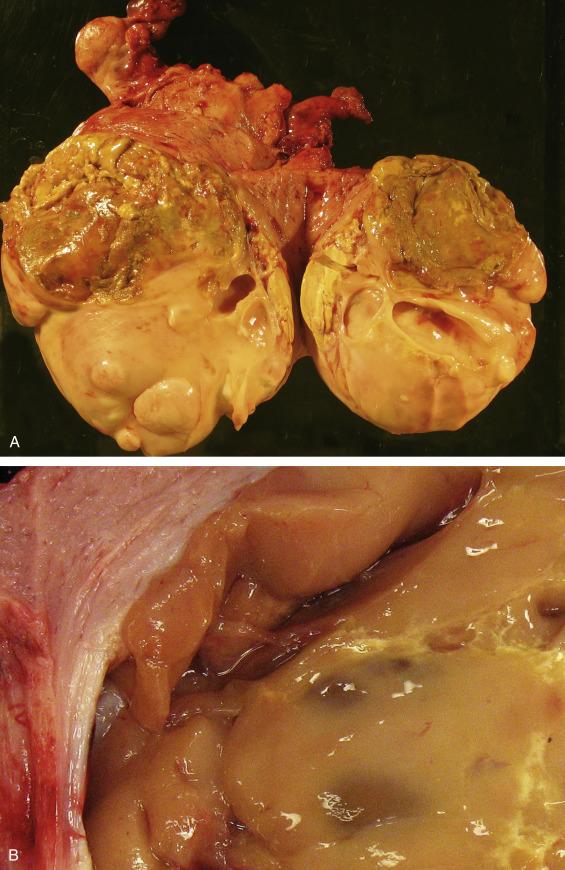
ESN is characterized by well demarcated and smooth borders ( Fig. 11.27A ). Bulging finger-like projections from the overall outer contour can be seen and are allowed for this diagnosis, as long as they are three or fewer in number and each measures less than 3 mm in length ( Fig. 11.27B ). Vascular space invasion is also, by definition, absent.
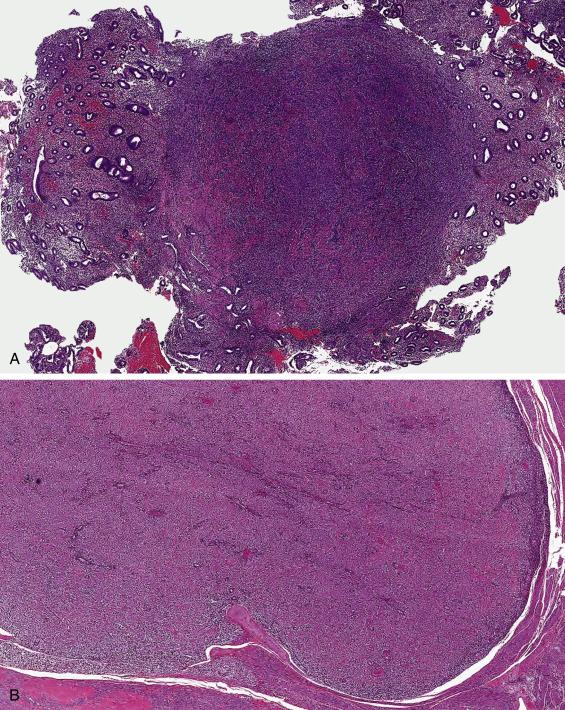
In conventional ESN, the neoplastic population highly resembles normal proliferative-phase endometrial stroma: it is cellular on low power magnification and composed of uniform cells with very scant cytoplasm and monotonous short-spindled to ovoid nuclei ( Fig. 11.27C ). The latter are two to four times larger than a lymphocyte nucleus; they have smooth membranes, uniform dark chromatin, and inconspicuous nucleoli. The number of mitoses varies but is usually low (less than 10 per 10 HPFs in >80% cases). The vasculature is distinctive and comprised of uniformly spaced, thin arteriole-sized vessels; thick or tortuously dilated vessels are absent, except at the tumor–myometrial interface occasionally. The stromal cells are surrounded by a scant collagenous matrix, which seldom becomes more prominent with hyalinized bands or ischemic-type change. Variant morphology is not uncommonly encountered and includes fibromyxoid, smooth muscle, skeletal muscle, sex cord stromal ( Fig. 11.27D ), and glandular differentiation (all covered in detail in the “Low-Grade Endometrial Stromal Sarcoma” section).
The neoplastic spindle cell component shows strong and diffuse expression of hormone receptors (ER, PR), CD10, WT1 and IFITM1. SMA is often positive. Desmin can be positive, sometimes in a diffuse distribution. Caldesmon is negative, except in areas of smooth muscle differentiation, which usually show positivity for all smooth muscle markers. Similarly, areas of sex cord differentiation may express SF1, calretinin, and inhibin. Keratin stains can show heterogeneous, nonspecific staining. Cyclin D1 and BCOR are expected to be negative, although these markers have not been tested in large numbers of ESNs.
Approximately 50%–65% of ESNs harbor a recurrent rearrangement of the JAZF1 and SUZ12 genes, resulting in a t(7:17)(p15:q21) fusion. This alteration is also the most frequent in LG-ESSs. Other fusions involving JAZF1 , PHF1 , and other genes, characteristic of LG-ESS, can also be found in ESN.
Given its high cellularity, the most common differential of ESN is with cellular leiomyoma . Smooth muscle tumors usually bulge on gross examination and have a distinctive fascicular architecture on microscopic examination. Moreover, the presence of thick-walled vessels throughout the tumor and elongated nuclei with tapered ends argue against ESN and is more in favor of leiomyoma. Despite the significant overlap in terms of smooth muscle and endometrial stromal marker expression, diffuse and strong SMA, desmin and/or caldesmon staining is more in keeping with leiomyoma. It is important to keep in mind that low-grade endometrial stromal tumors often have smooth muscle differentiation, which is usually minor but can exceed 30% of the tumor volume; thus, correlation of morphology with immunophenotype is essential. If the tumor exhibits significant sex cord stromal differentiation, uterine tumor resembling a sex-cord stromal tumor may be considered; however, by definition, this tumor entirely displays sex cord stromal morphology.
ESN and LG-ESS have identical tumor morphology, and the distinction between the two requires microscopic evaluation of the tumor border. A smooth, noninvasive tumor outline is diagnostic of ESN. Appreciation of the border is usually not possible in biopsy, curettage, or fragmented excisional material. When encountered in such specimens, and in the absence of obvious myometrial infiltration or vascular invasion, the tumor should be diagnosed as low-grade endometrial stromal neoplasm followed by a comment. Consideration for definitive surgery (hysterectomy) can be advised. As previously mentioned, ESN can have minimal myometrial infiltration. Very few cases that slightly exceed these parameters have been described as endometrial stromal tumors with limited infiltration . They are characterized by four to six tongue-like projections measuring up to 9 mm in maximum length from the tumor outer contour. Although they appear to be indolent like ESN, the experience in the literature is scarce, and careful clinical monitoring should be advised. HG-ESS with YWHAE-NUTM2 fusion may be on the differential if the tumor has areas with round (rather than spindled) nuclei; however, the size of the nuclei in ESN is small (≤4× lymphocyte nucleus); furthermore, tumor cells are strongly positive for CD10, ER, and PR and negative for cyclin D1 and BCOR, unlike HG-ESS.
ESN is considered benign. Given the limitations of making this diagnosis in biopsy material, hysterectomy is performed in most cases and is curative. Endometrial stromal tumors with limited infiltration require in addition close surveillance.
Neoplasm with morphology resembling proliferative-phase endometrial stroma and absent to only minimal infiltration (fewer than three projections, <3 mm from main mass) and no lymphovascular invasion
Uncommon
Fifth to sixth decades (median 47 years)
Abnormal uterine/postmenopausal bleeding
Pelvic or abdominal pain
Excellent prognosis
Completeness of excision with border visualization (hysterectomy) is required for diagnosis, also serves as definitive treatment.
Solitary well-circumscribed mass
Variable size, usually less than 10 cm (mean 7, range 0.5–22 cm)
Nonbulging soft yellow cut surface
Well-defined, nonencapsulated highly cellular lesion
Smooth, usually noninfiltrative interface with adjacent myometrium
Minimal border irregularity allowed, defined as up to three tongue-like processes, each less than 3 mm in size (measured from overall outer contour of tumor) without overt invasion or vascular invasion
Endometrial stromal tumor with limited infiltration: four to six projections, up to 9 mm in size
Uniform population of cells with scant cytoplasm
Short spindled to ovoid nuclei with uniform chromatin and inconspicuous nucleoli
Nuclear size with minimal variation (two to four times lymphocyte nucleus)
Mitotic rate <10/10 HPFs
Vasculature composed of evenly spaced and uniformly sized small arterioles
Thick blood vessels absent or confined to tumor periphery
No lymphovascular invasion
Variant morphology: smooth muscle, sex cord stroma, fibromyxoid
CD10, IFITM1, WT1, ER, and PR positive
SMA, desmin, calponin, and caldesmon frequently positive in areas of smooth muscle differentiation
Inhibin, calretinin, and SF1 may be in areas of sex cord–like differentiation
JAZF1-SUZ12 fusion most common (50%–65%)
Cellular leiomyoma
Uterine tumor resembling ovarian sex cord stromal tumor
Low-grade endometrial stromal sarcoma
YHWAE-NUTM2 high-grade endometrial stromal sarcoma
Become a Clinical Tree membership for Full access and enjoy Unlimited articles
If you are a member. Log in here